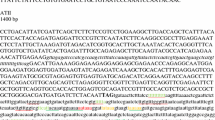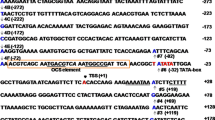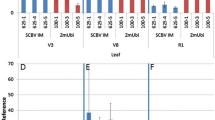Abstract
The contribution of sequences upstream and downstream of the transcription start site to the strength and specificity of the promoter of rice tungro bacilliform virus was analysed in transgenic rice plants. The promoter is strongly stimulated by downstream sequences which include an intron and is active in all vascular and epidermal cells. Expression in the vascular tissue requires a promoter element located between −100 and −164 to which protein(s) from rice nuclear extracts bind. Elimination of this region leads to specificity for the epidermis. Due to the presence of a polyadenylation signal in the intron, short-stop RNA is produced from the promoter in addition to full-length primary transcript and its spliced derivatives. The ratio between short-stop RNA and full-length or spliced RNA is determined by upstream promoter sequences, suggesting the assembly of RNA polymerase complexes with different processivity on this promoter.
Similar content being viewed by others
References
Bao, Y., Hull, R. 1993. Mapping the 5'-terminus of rice tungro bacilliform viral genomic RNA. Virology 197: 445–448.
Battraw, M. and Hall, T. 1990. Histochemical analysis of CaMV promoter-β-glucuronidase gene expression in transgenic rice plants. Plant Mol. Biol. 15: 527–538.
Bhattacharyya-Pakrasi, M., Peng, J., Elmer, J.S., Laco, G., Shen, P., Kaniewska, M.B., Kononowizc, H., Wen, F., Hodges, T.K. and Beachy, R.N. 1993. Specificity of a promoter from the rice tungro bacilliform virus for expression in phloem tissues. Plant J. 4: 71–79.
Bovy, A., van den Berg, C., de Vrieze, G., Thompson, W.F., Weisbeek, P. and Smeekens, S. 1995. Light-regulated expression of the Arabidopsis thaliana ferredoxin gene requires sequences upstream and downstream of the transcription initiation site. Plant Mol. Biol. 27: 27–39.
Burkhardt, P.K., Beyer, P., Wünn, J., Klöti, A., Armstrong, G.A., Schledz, M., von Lintig, J. and Potrykus, I. 1997. Transgenic rice (Oryza sativa) endosperm expressing daffodil (Narcissus pseudonarcissus) phytoene synthase accumulates phytoene, a key intermediate of provitamin A biosynthesis. Plant J. 11: 1071–1078.
Callis, J., Fromm, M. and Walbot, V. 1987. Introns increase gene expression in cultured maize cells. Genes Dev. 1: 1183–1200.
Caspar, T. and Quail, P.H. 1993. Promoter and leader regions involved in expression of the Arabidopsis ferredoxin A gene. Plant J. 3: 161–174.
Chen, G., Müller, M., Potrykus, I., Hohn, T. and Fütterer, J. 1994. Rice tungro bacilliform virus: transcription and translation in protoplasts. Virology 204: 91–100.
Chen, G., Rothnie, H.M., He, X., Hohn, T. and Fütterer, J. 1996. Efficient transcription from the rice tungro bacilliform virus promoter requires elements downstream of the transcription start site. J. Virol. 70: 8411–8421.
Chomczynski, P. and Sacchi, N. 1987. Single step method of RNA isolation by acid guanidinium thiocyanate-phenol-chloroform extraction. Anal. Biochem. 162: 156–159.
Christensen, A.H., Sharrock, R.A. and Quail, P.H. 1992. Maize polyubiquitin genes: structure, thermal perturbation of expression and transcript splicing, and promoter activity following transfer to protoplasts by electroporation. Plant Mol. Biol. 18: 675–689.
Clancy, M., Vasil, V., Hannah, L.C. and Vasil, I.K. 1994. Maize shrunken-1 intron and exon regions increase gene expression in maize protoplasts. Plant Sci. 98: 151–161.
Cornejo, M.J., Luth, D., Blankenship, K.M., Anderson, O.D. and Blechl, A.E. 1993. Activity of a maize polyubiquitin promoter in transgenic rice. Plant Mol. Biol. 23: 567–581.
Curie, C., Axelos, M., Bardet, C., Atanassova, R., Chaubet, N. and Lescure, B. 1993. Modular organization and developmental activity of an Arabidopsis thaliana EF-1α gene promoter. Mol. Gen. Genet. 238: 428–436.
Curie, C. and McCormick, S. 1997. A strong inhibitor of gene expression in the 5' untranslated region of the pollen-specific LAT59 gene of tomato. Plant Cell 9: 2025–2036.
De Almeida, E.R.P., Gossele, V., Muller, C.G., Dockx, J., Reynaerts, A., Botterman, J., Krebbers, E. and Timko, M.P. 1989. Transgenic expression of two marker genes under the control of an Arabidopsis rbcs promoter: sequences encoding the Rubisco transit peptide increase expression levels. Mol. Gen. Genet. 218: 78–86.
Dean, C., Favreau, M., Bond-Nutter, D., Bedbrook, D. and Dunsmuir, P. 1989. Sequences downstream of translation start regulate quantitative expression of two petunia rbcs genes. Plant Cell 1: 201–208.
Depicker, A. and Van Montagu, M. 1997. Post-transcriptional gene silencing in plants. Curr. Opin. Cell. Biol. 9: 373–382.
Donath, M., Mendel, R., Cerff, R. and Martin, W. 1995. Introndependent transient expression of the maize GapA1 gene. Plant Mol. Biol. 28: 667–676.
Douglas, C.J., Hauffe, K.D., Ites-Morales, M.-E., Ellard, M., Paszkowski, U., Hahlbrock, K. and Dangl, J.L. 1991. Exonic sequences are required for elicitor and light activation of a plant defense gene, but promoter sequences are sufficient for tissue specific expression. EMBO J. 10: 1767–1775.
Frisch, D.A., van der Geest, A.H.M., Dias, K. and Hall, T.C. 1995. Chromosomal integration is required for spatial regulation of expression from the β-phaseolin promoter. Plant J. 7: 503–512.
Frustaci, J.M., Sangwan, I. and O'Brian, M.R. 1995. gsa1 is a universal tetrapyrrole synthesis gene in soybean and is regulated by a GAGA element. J. Biol. Chem. 270: 7387–7393.
Fu, H., Kim, S.Y. and Park, W.D. 1995. High-level tuber expression and sucrose inducibility of a potato Sus4 sucrose synthase gene require 5' and 3' flanking sequences and the leader intron. Plant Cell 7: 1387–1394.
Fütterer, J., Potrykus, I., Valles Brau, M.P., Dasgupta, I., Hull, R. and Hohn, T. 1984. Splicing in a plant pararetrovirus. Virology 198: 663–670.
Fütterer, J., Potrykus, I., Bao, Y., Li, L., Burns, T.M., Hull, R. and Hohn, T. 1996. Position-dependent ATT initiation during plant pararetrovirus rice tungro bacilliform virus translation. J. Virol. 70: 2999–3010.
Fütterer, J., Rothnie, H.M., Hohn, T. and Potrykus, I. 1997. Rice tungro bacilliform virus open reading frames II and III are translated from polycistronic pregenomic RNA by leaky scanning. J. Virol. 71: 7984–7989.
Genschick, P., Marbach, M., Uzé, M., Feuerman, B., Plesse, B. and Fleck, J. 1994. Structure and promoter activity of a stress and developmentally regulated polyubiquitin-encoded gene of Nicotiana tabacum. Gene 148: 195–202.
Gidekel, M., Jimenez, B. and Herrera-Estrella, L. 1996. The first intron of the Arabidopsis thaliana gene coding for elongation factor 1β contains an enhancer-like element. Gene 170: 201–206.
Gu, W. and Reines, D. 1995. Identification of a decay in transcription potential that results in elongation factor dependence of RNA polymerase II. J. Biol. Chem. 270: 11238–11244.
Guilfoyle, T.J. 1997. The structure of plant gene promoters. Genet. Engin. 19: 15–47.
Hay, J.M., Jones, M.C., Blackebrough, M.L., Dasgupta, I., Davies, J.W. and Hull, R. 1991. An analysis of the sequence of an infectious clone of rice tungro bacilliform virus, a plant pararetrovirus. Nucl. Acids Res. 19: 2615–2621.
Hibino, H. 1996. Biology and epidemiology of rice viruses. Annu. Rev. Phytopath. 34: 249–274.
Hohn, T., Corsten, S., Rieke, S., Müller, M. and Rothnie, H. 1996. Methylation of coding regions alone inhibits gene expression in protoplasts. Proc. Natl. Acad. Sci. USA 93: 8334–8339.
Hull, R. 1996. Molecular biology of rice tungro viruses. Annu. Rev. Phytopath. 34: 275–297.
Jefferson, R.A. 1987. Assaying chimeric genes in plants: the GUS gene fusion system. Plant Mol. Biol. Rep. 5: 387–405.
Jones, K.A. 1997. Taking a new TAK on Tat transactivation. Genes Dev. 11: 2593–2599.
Jones, K.A., Peterlin, B.M. 1994. Control of RNA initiation and elongation at the HIV-1 promoter. Annu. Rev. Biochem. 63: 717–743.
Keen, N.J., Churcher, M.J. and Karn, J. 1997. Transfer of Tat and release of TAR RNA during the activation of the human immunodeficiency virus type-1 transcription elongation complex. EMBO J. 16: 5260–5272.
Krumm, A., Hickey, L.B. and Groudine, M. 1995. Promoterproximal pausing of RNA polymerase II defines a general rate-limiting step after transcription initiation. Genes Dev. 9: 559–572.
Kyozuka, J., Olive, M., Peacock, W.J., Dennis, E.S. and Shimamoto, K. 1994. Promoter elements required for the developmental expression of the maize Adh1 gene in transgenic rice. Plant Cell 6: 799–810.
Lam, E. 1994. Analysis of tissue-specific elements in the CaMV 35S promoter. In: I. Nover (Ed.), Results and Problems in Cell Differentiation, Springer-Verlag, Berlin/Heidelberg, pp. 181–196.
Larkin, J.C., Oppenheimer, D.G., Pollock, S. and Marks, M.D. 1993. Arabidopsis GLABROUS1 gene requires downstream sequences for function. Plant Cell 5: 1739–1748.
Li, Y.-Z., M, H.-M., Zhan, J.-L., Wan, Z.-Y. and Hon, M.-M. 1995. Effects of the first intron of rice Waxy gene on the expression of foreign genes in rice and tobacco protoplasts. Plant Sci. 108: 181–190.
Lois, R., Dietrich, A. and Hahlbrock, K. 1989. A phenyalanine ammonia-lyase gene from parsley: structure, regulation and identification of elicitor and light responsive cis-acting elements. EMBO J. 8: 1641–1648.
Lu, X., Welsh, T.M. and Peterlin, B.M. 1993. The human immunodeficiency virus type 1 long terminal repeat specifies two different transcription complexes, only one of which is regulated by Tat. J. Virol. 67: 1752–1760.
Luehrsen, K.R. and Walbot, V. 1991. Intron enhancement of gene expression and the splicing efficiency of introns in maize cells. Mol. Gen. Genet. 225: 81–93.
Maas, C., Laufs, J., Grant, S., Korfhage, C. and Werr, W. 1991. The combination of a novel stimulatory element in the first exon of the maize shrunken-1 gene with the following intron enhances reporter gene expression 1000-fold. Plant Mol. Biol. 16: 199–207.
Mascarenhas, D., Mettler, I.J., Pierce, D.A. and Lowe, H.W. 1990. Intron mediated enhancement of heterologous gene expression in maize. Plant Mol. Biol. 15: 913–920.
Matsumura, T. and Tabayashi, N. 1995. Transformation of rice plants by plant reovirus genes. Semin. Virol. 6: 133–139.
McElroy, D., Zhang, W. and Wu, R. 1990. Isolation of an efficient promoter for use in rice transformation. Plant Cell 2: 163–171.
Medberry, S.L. and Olszewski, N.E. 1993. Identification of ciselements involved in commelina yellow mottle virus promoter activity. Plant J. 3: 619–626.
Mendel, R.R., Müller, B., Schulze, J., Kolesnikov, V. and Zelenin, A. 1989. Delivery of foreign genes to intact barley cells by highvelocity microprojectiles. Theor. Appl. Genet. 78: 31–34.
Norris, S.R., Meyer, S.E. and Callis, J. 1993. The intron of Arabidopsis thaliana polyubiquitin genes is conserved in location and is a quantitative determinant of chimeric gene expression. Plant Mol. Biol. 21: 895–906.
Oard, J.H., Paige, D. and Dvorak, J. 1989. Chimeric gene expression using maize intron in cultured cells of breadwheat. Plant Cell Rep. 8: 156–160.
Pierce, D.A., Mettler, I.J., Lachmansingh, A.R., Pomeroy, L.M., Weck, E.A. and Mascarenhas, D. 1987. Effect of 35S leader modifications on promoter activity. In: J.L. Key and L. McIntosh (Eds.), Plant Gene Systems and their Biology, UCLA Symposia on Molecular and Cell Biology, New series 62: 301–310.
Qu, R., Bhattacharyya, M., Laco, G.S., de Kochko, A., Rao, S., Kaniewska, M.B., Elmer, S., Rochester, D.E., Smith, C.E. and Beachy, R.N. 1991. Characterization of the genome of rice tungro bacilliform virus, comparison with commelina yellow mottle virus and caulimoviruses. Virology 185: 354–364.
Rasmussen, E.B. and Lis, J.T. 1995. Short transcripts of the ternary complex provide insight into RNA polymerase II elongational pausing. J. Mol. Biol. 252: 522–535.
Rathus, C., Bower, R. and Birch, R.G. 1993. Effects of promoter, intron and enhancer elements on transient expression in sugarcane and carrot protoplasts. Plant Mol. Biol. 23: 613–618.
Reeder, T.C. and Hawley, D.K. 1996. Promoter proximal sequences modulate RNA polymerase II elongation by a novel mechanism. Cell 87: 767–777.
Rose, A.B. and Last, R.L. 1997. Introns act post-transcriptionally to increase expression of the Arabidopsis thaliana tryptophan pathway gene PAT1. Plant J 11: 455–464.
Rothnie, H.M., Chapdelaine, Y. and Hohn, T. 1994. Pararetroviruses and retroviruses, a comparative review of viral structure and gene expression strategies. Adv. Virus Res. 44: 1–67.
Rothnie, H.M. 1996. Plant mRNA 30-end formation. Plant Mol. Biol. 32: 43–61.
Sanfaçon, H., Hohn, T. 1990. Proximity to the promoter inhibits recognition of cauliflower mosaic virus polyadenylation signal. Nature 346: 81–84.
Sanger, M., Daubert, S.D. and Goodman, R.M. 1990. Characteristics of a strong promoter from figwort mosaic virus: comparison with the analogous 35S promoter from cauliflower mosaic virus and the regulated mannopine synthase promoter. Plant Mol. Biol. 14: 433–443.
Scott, J.M. and Imperiale, M.J. 1997. Promoter-proximal poly(A) sites are processed efficiently, but the RNA products are unstable in the nucleus. Mol. Cell. Biol. 17: 2127–2135.
Shopland, L.S., Hirayoshi, K., Fernandes, M. and Lis, J.T. 1995. HSF access to heat shock elements in vivo depends critically on promoter architecture defined by GAGA factor, TFIID, and RNA polymerase II binding sites. Genes Dev. 9: 2756–2769.
Sieburth, L.E. and Meyerowitz, E. 1997. Molecular dissection of the AGAMOUS control region shows that cis elements for spatial regulation are located intragenically. Plant Cell 9: 355–365.
Simpson, G.G. and Filipowicz, W. 1996. Splicing of precursors to mRNA in higher plants: mechanism, regulation and sub-nuclear organisation of the spliceosomal machinery. Plant Mol. Biol. 32: 1–41.
Sinibaldi, R.M. and Mettler, I.J. 1992. Intron splicing and intronmediated enhanced expression in monocots. Prog. Nucl. Acids Mol. Biol. 42: 229–257.
Snowden, K.C., Buchholz, W.G. and Hall, T.C. 1996. Intron position affects expression from the tpi promoter in rice. Plant Mol. Biol. 31: 689–692.
Tanaka, A., Mita, S., Ohta, S., Kyozuka, J., Shimamoto, K. and Nakamura, K. 1990. Enhancement of foreign gene expression by a dicot intron in rice but not in tobacco is correlated with an increased level of mRNA and an efficient splicing of the intron. Nucl. Acids Res. 18: 6767–6770.
Terada, R. and Shimamoto, K. 1990. Expression of CaMV 35SGUS gene in transgenic rice plants. Mol. Gen. Genet. 220: 389–392.
Turner, D.S., McCallum, D.G. and Covey, S.N. 1996. Roles of the 35S promoter and multiple overlapping domains in the pathogenicity of the pararetrovirus cauliflower mosaic virus. J. Virol. 70: 5414–5421.
Tzafrir, I., Torbert, K.A., Lockhart, B.E.L., Somers, D.A. and Olszewski, N.E. 1998. The sugarcane bacilliform badnavirus promoter is active in both monocots and dicots. Plant Mol. Biol. 38: 347–356.
Vasil, V., Clancy, M., Ferl, R.J., Vasil, I.K. and Hannah, L.C. 1989. Increased gene expression by the first intron of maize shrunken-1 locus in grass species. Plant Physiol. 91: 1575–1579.
Verdaguer, B., deKochko, A., Beachy, R.N. and Fauquet, C. 1996. Isolation and expression in transgenic tobacco and rice plants, of the cassava vein mosaic virus (CVMV) promoter. Plant Mol. Biol. 31: 1129–1139.
Waldron, C., Murphy, E.B., Roberts, J.L., Gustafson, G.D., Armour S.L. and Malcolm, S.K. 1985. Resistance to hygromycin B: a new marker for plant transformation studies. Plant Mol. Biol. 5: 103–108.
Wal, G., Varga-Weisz, P.D., Sandaltzopoulos, R. and Becker, P.B. 1995. Chromatin remodeling by GAGA factor and heat shock factor at the hypersensitive Drosophila hsp26 promoter in vitro. EMBO J. 14: 1727–1736.
Wang, D., Severinov, K. and Landick, R. 1997. Preferential interaction of the his pause RNA hairpin with RNA polymerase β subunit residues 904–950 correlates with strong transcriptional pausing. Proc. Natl. Acad. Sci. USA 94: 8433–8438.
Wilkins, R.C. and Lis, J.T. 1997. Dynamics of potentiation and activation: GAGA factor and its role in heat shock gene regulation. Nucl. Acids Res. 25: 3936–3968.
Wong, E.Y., Hironaka, C.M. and Fischoff, D.A. 1992. Arabidopsis thaliana small subunit leader and transit peptide enhances the expression of Bacillus thuringiensis proteins in transgenic plants. Plant Mol. Biol. 20: 81–93.
Wünn, J., Klöti, A., Burkhardt, P.K., Ghosh Biswas, G.C., Launis, K., Iglesias, V.A. and Potrykus, I. 1996. Transgenic Indica rice breeding line IR58 expressing a synthetic cryIA(b) gene from Bacillus thuringiensis provides effective insect pest control. Bio/technology 14: 171–176.
Xu, D., McElroy, D., Thornburg, R.W. and Wu, R. 1993. Systemic induction of a potato pin2 promoter by wounding, methyl jasmonate, and abscisic acid in transgenic rice plants. Plant Mol. Biol. 22: 573–588.
Xu, D., Lei, M. and Wu, R. 1995. Expression of the rice Osgrp1 promoter-GUS reporter gene is specifically associated with cell elongation/expansion and differentiation. Plant Mol. Biol. 28: 455–471.
Yin, Y. and Beachy, R.N. 1995. The regulatory regions of the rice tungro bacilliform virus promoter and interacting nuclear factors in rice (Oryza sativa L). Plant J. 7: 969–980.
Yin, Y., Zhu, Q., Da, S., Lamb, C. and Beachy, R.N. 1997a. RF2a, a bZIP transcriptional activator of the phloem-specific rice tungro bacilliform virus promoter, functions in vascular development. EMBO J. 16: 5247–5259.
Yin, Y., Chen, L. and Beachy, R. 1997b. Promoter elements required for phloem-specific gene expression from the RTBV promoter in rice. Plant J. 12: 1179–1188.
Author information
Authors and Affiliations
Rights and permissions
About this article
Cite this article
Klöti, A., Henrich, C., Bieri, S. et al. Upstream and downstream sequence elements determine the specificity of the rice tungro bacilliform virus promoter and influence RNA production after transcription initiation. Plant Mol Biol 40, 249–266 (1999). https://doi.org/10.1023/A:1006119517262
Issue Date:
DOI: https://doi.org/10.1023/A:1006119517262




